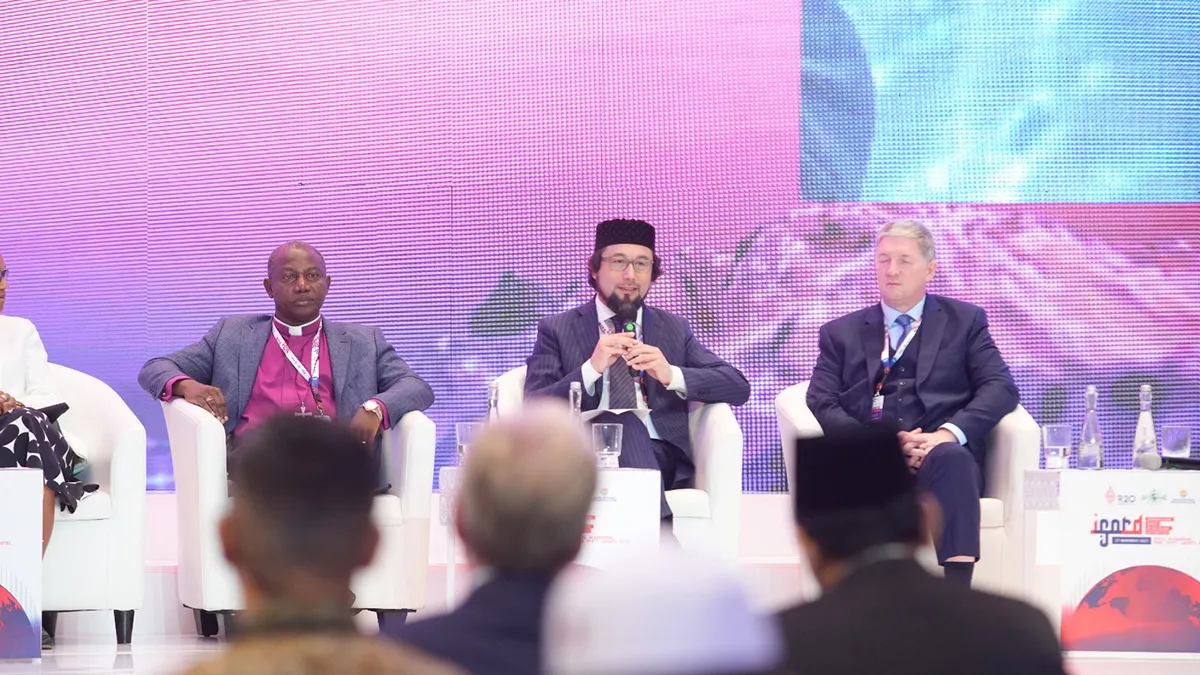
On Wednesday, February 28, 2024, an important conference on interreligious dialogue was held in Milan, Italy, at the State University, on the occasion of the 30th anniversary of the "Italian Islamic Religious Community" (COREIS), with the participation of scholars and representatives from the Jewish, Christian and Islamic worlds. Among others, the Archbishop of Milan, Mario Delpini, the Chief Rabbi of Milan, Rav Alfonso Arbib, the President of COREIS, Abu Bakr Moretta, and the Vice-President of the same religious community and President of the "Council of Muslim Leaders of Europe" (EULEMA), Imam Yahya Pallavicini, were present. The event, under the patronage from Abu Dhabi of the "Council of Wise Muslims," and chaired by Imam Ahmad al-Tayyeb, had been included among the initiatives of the "Week for World Interfaith Harmony" (WIHM, i.e.: "World Interfaith Harmony Week") that the United Nations General Assembly, since 2010, has been promoting annually upon the proposal of the Royal House of Jordan.
That important initiative was only the latest of the many that the "Coreis" has been promoting and advocating for the past 30 years in Italy and abroad to foster and encourage freedom of religion and to try to create a dialogue between the three great religions of the Abrahamic stock: Judaism, Christianity and Islam.
Taking a cue from that conference, as FOB Secretary General, I am particularly pleased to be able to write some brief notes on the history and activities of that well-deserving Religious Community (COREIS), founded in Milan by Shaykh 'Abd al Wahid Pallavicini (born: Felice Pallavicini; 1926-2017), a true pioneer of Islam in Italy.
Many of us who were fortunate enough to know Shaykh Pallavicini personally will remember with emotion his extraordinary humanity and passionate love for Sufism and the world of Islamic spirituality to which he had dedicated his entire life. I see him as if it were yesterday, tall and massive as an oak tree, with an ascetic appearance, long white beard, aquiline nose and piercing gaze. I had the opportunity to meet him several times during some conferences in Rimini and other Italian cities, but also at numerous interfaith events. One of the most vivid memories I have of him was when I went to visit his Mosque in Milan. On that occasion I also got to meet his wife, a kind and delicate Japanese lady. Shaykh Pallavicini, wore a long gray cotton robe, with a sleeveless black caftan over it; on his head was his usual white skullcap. Together, drinking a few good cups of coffee, we talked about Sufism and Hesychasm, but also about Chinese and Japanese prints and the many similarities between the different forms of contemplation of East and West. I had recently returned from a long period of study in Japan and I spoke to him enthusiastically about my research on Japanese esoteric Buddhism and its meditative practices. He listened to me patiently and then confessed that while he felt the utmost respect for that tradition, he had never been particularly attracted by it because he had always felt anchored in the tradition of Christian and Islamic monotheism. Then, he added, that he did not see much difference between Christianity and Islam. For him, Christianity and Islam were sister religions. However, historically, Islam, compared to Christianity, would be a later revelation of the One God. In practice, Islam could have been seen as the completion of a revelation that occurred in three stages: the first would have manifested itself with Judaism, the second with the message of Jesus, the "Master of the Breath" (i.e.: the "Divine Spirit"), and finally, the third and last, with the advent of the prophet Muhammad.
Pallavicini's conversion to Islam, which took place in Switzerland on January 7, 1951, with the pronouncement of the "Profession of Faith" (shahada) in front of the philosopher Titus Burckhardt (Ibrahim Izz al-Din, 1908-1984), would only have marked his deeper and more complete adherence to the One God ("Allah," in Arabic). Oddly enough, on the very same day, Jan. 7, in Cairo, his spiritual master, René Guénon (Shaykh 'Abd al-Wahid Yahya; 1886-1971), the great French orientalist and metaphysician who had joined Islam a full forty years earlier, died. Perhaps, it was for that very reason that Pallavicini decided to take the name 'Abd al-Wahid (i.e.: "Servant of the One God") that had been that of his spiritual masterAnd, following the teachings of that great master, Pallavicini grew closer and closer to Sufism, a mystical current of Islam that practices asceticism, detachment from worldly things, silence and contemplation of God (Allah). The honorary title of "Shaykh" (i.e.: " Wise One") was conferred on him many years later: in 1970, in Singapore.
After his conversion, the first periods were not easy; Italians did not understand why he joined Islam, and frankly, neither did Muslims. At that time, a real cultural illiteracy reigned in Italy regarding the Islamic religion and Sufism. Precisely to make up for that lack of knowledge, in 1993, 'Abd al-Wahid Pallavicini, together with some Italian intellectual converts, founded the "Associazione Internazionale per l'Informazione sull'Islam" (AIII) in Milan. In the beginning, the activities of that association focused only on an intense cultural activity; but then, as time went on, in order to meet the needs of Muslims, more and more numerous in Italy, that association was transformed into a religious body which, since 1997, with a new statute, was called COREIS.
At the guidance of that body, Shaykkh Pallavicini always preached moderation and respect for religions and other people's opinions, and he spared no criticism against those who exploited religion for selfish or political ends. His commitment to interreligious dialogue and peace also led him to the famous ecumenical meeting in Assisi (1986) where he had the opportunity to shake hands with Pope John Paul II.
In 1996, COREIS submitted to the Italian government an initial proposal for an understanding with the state. On that occasion it hypothesized an "Islam fully compatible with Italian society and its legal system." In the same year he signed an agreement with ISESCO, the educational-cultural body of the Organization of the Islamic Conference. From 1998 he then joined the National Commission for Intercultural Education organized by the Ministry of Education and began training a corps of Muslim teachers who, throughout Italy, still give update courses to teachers.
The following year, COREIS joined the executive board of the "Heritage and Memory in Mediterranean Culture" Committee at the Ministry of Cultural and Environmental Heritage, and stipulated a cooperation agreement with the Federico II University of Naples. COREIS also has a presence in France. In fact, the IHEI (Institut des Hautes Etudes Islamiques) is chaired by Imam Yahya Pallavicini, son of Shaykh Pallavicini, who took over as director of COREIS upon his father's death.
Yahya Pallavicini, who was born a Muslim in 1965, had been able to deepen the knowledge he had from his father by studying Islamology at the "Sapienza" University in Rome with Alessandro Bausani (1923-1988) and Biancamaria Scarcia Amoretti (1938-2020), and then at the PISAI (Pontifical Institute of Arabic Studies and Islamistics). But not only that, because, in Paris, at the Grand Mosque, he also had the honor of taking courses from a famous spiritual master who would later be killed in Syria by jihadists, Shaykh Muhammed Sa'id Ramadān al-Būtī (1929-2013). He later completed his education in Cairo and at the International Institute of Islamic Thought and Civilization (ISTAC) in Malaysia.
Yahya Pallavicini, is a member of the European Council of Religious Leaders (ECRL) and an ISESCO Ambassador for Dialogue between Cultures and Civilizations. In addition, since 2005, he has been a member of the "Council on Islam in Italy," a body wanted by the Ministry of the Interior. Since that same year, COREIS, as a representative body of the Islamic faith present in Italy, has been accredited with the Ministry of the Interior.
Imam Yahya Pallavicini has written many books and published articles and essays in specialized journals and newspapers. In addition, he has given numerous lectures both in Italy and abroad. It would be useless to try to list even a small number of them. Among his most recent lectures, however, I like to mention the one he gave on November 27, 2023, in Jakarta, in the context of the "R20 Summit of International Religious Authorities" (ISORA). The theme of that conference, which was attended by the most prominent spiritual leaders of major religious traditions, was on the relationship between religions and violence: "Religion's Role in Addressing Middle East Violence and Threats to Rules-based International Order".

At center Imam Yahya Pallavicini in Jakarta
I would like to conclude with a few sentences from the speech that Imam Yahya Pallavicini delivered on that occasion. The theme of the discussion was on " liberation from the violence of wars, in an authentically religious perspective": "... ( the authentic liberation is that) from the evil of ignorance and the criminal and ideological instrumentalisation of religion; it is liberation from the corruption of politics that becomes militant and war-mongering tyranny instead of being a service to the people and their outward and inner development. It is necessary to get rid of the external evil by starting with the internal evil without speculating on blame or concauses or the number of victims or the level of atrocity of others in order to conceal the relevant absence of concrete educational and social good offered to one's people. Liberation from Error (al-munqidh min al-dalai), is the title of a biographical work by Imam Abū Hamid al-Ghāzalī (1058-1111) that teaches us that this liberation is a liberation from darkness into light, into the light of Muhammadan Enlightenment, a celestial and primordial light that enables us to see reality for what it truly is and to recognize above all that which is invisible and which transcends the ordinary plane of superficial appearances of forms.... The realization of this spiritual liberation and enlightenment may also result in liberation from corruption and oppression.... It will be a Liberation toward Good! A common good, not a good against the other or without the other!" (taken from: coreis.it. Also published by the journal “Sacrum et Polis”).
Taking my cue from these last considerations of my friend Yahya, I would like to conclude my reflections with a thought from one of the greatest musicians of all time, with the words Ludwig van Beethoven (1770-1827) wrote to his brother Johan back in 1802: "... Only music, as an ascesis of the spirit, has educated me and saved me from despair and loneliness. Thus I set Schiller's Ode to Joy to music for the Ninth Symphony." Even today that Hymn is called "to Joy"; but by calling all men "brothers" in joy, Schiller's Hymn and Beethoven's music rise to a universal and eternal prophetic value. The path of spiritual ascesis pointed out by Beethoven to lead everything back to its true source and inner awakening is the same "liberation from darkness to light," proposed by Shaykh 'Abd al-Wahid and Imam Yahya Pallavicini. The Hymn to Joy and Brotherhood, today should be called "Hymn to true freedom from all forms of darkness, doctrinal instrumentalization or corruption," and why not, even "Hymn to Peace"! This is the time.
SILVIO CALZOLARI
The national headquarters of COREIS is in Milan, next to the al-Wahid Mosque at 9 og Via Giuseppe Meda. The venue is officially recognized by the City of Milan and received, in 2008, a certificate of civic merit for interreligious and intercultural dialogue.





